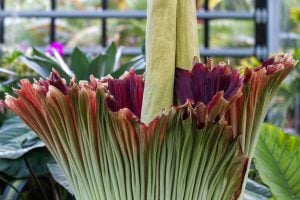Corpse Flower Prepares to Bloom at San Diego Botanic Garden
(June 28, 2024)
This rare and stinky plant is expected to bloom over the next week, offering visitors just 48-hours to see and catch a whiff of the magnificent bloom
SAN DIEGO – San Diego Botanic Garden (SDBG), located in Encinitas, announces the expected blooming of one of the world’s rarest and smelliest plants, a corpse flower (Amorphophallus titanum). The flower is expected to bloom over the next week, and once in full bloom will emit its pungent odor for only 48-hours. The corpse flower is currently on display in the Dickinson Family Education Conservatory at the Garden.
“The blooming of a corpse flower has become an international sensation, intriguing people from around the world with its fleeting flower,” said SDBG President and CEO, Ari Novy, PhD. “We are extremely fortunate to be presenting a bloom from our permanent collection, making this year’s bloom even more special. The heat and smell are used to attract pollinator insects, while also attracting curious humans excited to experience this beautiful and smelly rock star of the plant world.”
The blooming of a corpse flower is a rare and special event, as most of these plants require seven to ten years to produce their first blooms, and bloom only every four to five years thereafter. This particular corpse flower last bloomed three years ago at SDBG in November 2021, making its upcoming bloom even more rare. Over the next week, the flower will continue to grow until attaining its peak bloom height and then finally open up to display its full and stinky glory.
The corpse flower gets its name from its odor, which has been commonly described as a rotting corpse or carcass. Once in full bloom, the plant will emit its stench for just two days, and then stay up for 3-4 days before it begins to close and slowly decay over the following days. Since the floral odor is strongest in the evening, SDBG will extend its hours to midnight for the two nights of bloom, allowing guests a chance to see – and smell – this rare phenomenon in full splendor. For those unable to visit at night, special early morning viewing hours will also be available starting at 7 am on the second and third days following the bloom. Specific dates will be announced once the plant begins to bloom. The flower will remain on display during regular daytime hours until it decays.
The corpse flower is characterized as a carrion flower that attracts carcass-eating insects. Native to the rainforests of Sumatra, the humid climate that this rare and endangered plant grows in will be replicated in the San Diego Botanic Garden’s 8,000 square-foot Dickinson Family Education Conservatory.
For those unable to visit in person, a 24-hour live stream of the plant is available online. While the exact bloom date cannot be determined, SDBG will regularly update its website and social media, along with hosting a naming competition for the bloom via social media. This plant’s previous bloom in 2021 was named “Stinking Beauty”.
Ticket reservations are required. After-hours admission on specified bloom days includes entrance to the Conservatory building only, as the rest of the Garden will be closed after 5 p.m. SDBG Members receive free admission. Pricing for non-members is $18 for Adults, $10 for children 3-12, and free for ages 2 and under. Discounted pricing is available for military, students, and seniors ages 60+. For more information on San Diego Botanic Garden and to plan your visit, please visit www.sdbg.org.
###
About San Diego Botanic Garden:
Established in 1970, San Diego Botanic Garden (SDBG) is a 37-acre urban oasis located in Encinitas, California, just north of San Diego. The Garden’s four miles of trails and 8,000 square foot glass conservatory display more than 5,300 plant species and varieties. A premiere institution for botanical science and conservation, SDBG is actively involved in conservation horticulture, botany, and applied plant sciences to address our biggest local and global challenges, from biodiversity loss to climate change, food insecurity to environmental degradation. SDBG has the largest public bamboo collection in North America; gardens representing different regions and flora of the world; three children’s gardens, and demonstration gardens showcasing fruits and vegetables, water-smart ornamentals, and native plants. Through an array of educational programming, events and activities for both children and adults, the Garden aims to create, share, and apply plant wisdom to the world.
